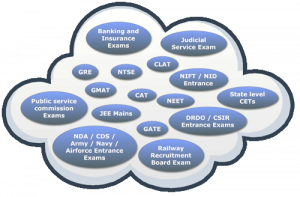Best Books to Read in 2023
Best Books to Read in 2023 Are you a bookworm or a bibliophile, if yes, then this is the ...
Have you pondered about India’s many educational paths? The National Eligibility Test (NET) and State Eligibility Test (SET) provide different chances and difficulties. Each path offers unique chances and challenges: the National Eligibility Test (NET) and the State Eligibility Test (SET). But what distinguishes them? What should prospective academics consider while deciding between these paths? This extensive comparison illuminates the differences between NET and SET tests, their aim, scope, and consequences for Indian educators.

The primary distinction between NET and SET lies in their scope and purpose. NET, conducted nationally by the National Testing Agency (NTA) under the aegis of the University Grants Commission (UGC), evaluates candidates for Assistant Professorships and JRF positions across the entire nation. Conversely, SET, administered by individual state agencies, serves to assess candidates solely for Assistant Professor roles within specific states. This delineation underscores the national versus regional focus of these examinations, catering to the diverse educational landscapes across India.
NET and SET are governed by distinct authorities. The NTA oversees the administration of NET, ensuring compliance with UGC guidelines on a national scale. On the other hand, state agencies run SET autonomously while adhering to UGC guidelines and meeting the unique educational needs and standards that are prevalent in each state. This decentralized approach in conducting SET underscores the diversity and autonomy of educational governance across Indian states.
The frequency of NET and SET examinations varies significantly. NET is conducted bi-annually, offering candidates two opportunities annually to demonstrate their eligibility for Assistant Professorships and JRF. In contrast, SET is typically held once a year in each respective state, aligning with the localized nature of this examination. This disparity in frequency underscores the differing approaches to examination scheduling and administration between national and state-level assessments.

Language plays a pivotal role in the administration of NET and SET examinations. While NET is primarily conducted in English and Hindi, catering to a broader national audience, SET accommodates linguistic diversity by offering question papers in both English and vernacular languages specific to each state. This linguistic inclusivity in SET ensures accessibility and comprehension for candidates from diverse linguistic backgrounds, fostering a more equitable examination environment.
The syllabi for NET and SET examinations exhibit notable disparities reflective of their respective scopes. NET maintains a consistent syllabus across India, encompassing 81 subjects and catering to diverse academic disciplines. In contrast, SET adopts a tailored approach, with each state devising its syllabus to address regional educational needs and priorities. This localized syllabus design ensures relevance and contextual alignment with the educational landscape of each state, thereby enhancing the efficacy of SET as a state-level assessment tool.
The eligibility criteria for NET and SET examinations exhibit varying degrees of stringency and flexibility. NET imposes stringent criteria, including minimum marks requirements and age limits for JRF eligibility, reflecting the rigorous standards upheld at the national level. In contrast, SET offers relatively flexible eligibility criteria, with no age restrictions and varying qualification thresholds across states. This flexibility in SET criteria accommodates diverse academic backgrounds and experiences, fostering inclusivity and accessibility for aspiring educators within each state.
The examination patterns of NET and SET entail distinct formats and assessment methodologies. NET comprises two papers, assessing teaching aptitude, subject knowledge, and research ability, with a total duration of three hours. In contrast, SET features two papers evaluating reasoning, comprehension, and subject-specific knowledge, tailored to the educational priorities of each state. This divergence in exam patterns underscores the nuanced approaches adopted in assessing candidates’ readiness for Assistant Professor roles at national and state levels.

The career prospects stemming from NET and SET qualifications differ in scope and breadth. NET opens doors to teaching and research positions nationwide, enabling candidates to pursue opportunities in diverse educational institutions across India. Conversely, SET qualifies candidates for Assistant Professor roles exclusively within the respective states where they have cleared the examination, limiting the geographical scope of employment opportunities. This disparity underscores the broader national recognition associated with NET qualifications compared to the regional focus of SET certifications.
Comparison Between NET and SET Exams
| Aspect | NET | SET |
|---|---|---|
| Purpose | National Eligibility Test | State Eligibility Test |
| Conducting Authorities | National Testing Agency (NTA) | State Agencies |
| Frequency | Bi-annual | Once a year (per state) |
| Medium of Examination | English, Hindi | English, Vernacular Languages (State-specific) |
| Syllabus | Consistent across India (81 subjects) | State-specific |
| Eligibility Criteria | Stringent | Relatively flexible |
| Exam Pattern | Two papers | Two papers |
| Career Opportunities | National | State-specific |
Variants of State Eligibility Tests
Several states in India conduct their variants of the State Eligibility Test (SET), tailored to the educational priorities and needs of their respective regions.
| State | Variant |
|---|---|
| West Bengal | WB SET |
| Chhattisgarh | CG SET |
| Himachal Pradesh | HP SET |
| Jammu & Kashmir | JK SET |
| Assam | Assam SLET |
| Madhya Pradesh | MP SET |
| Gujarat | GSET |
| Maharashtra (MH SET)/UNIPUNE | SET |
| Rajasthan | RSET |
| Telangana | TSSET |
| Tamil Nadu | TNSET |
| Kerala | Kerala SET |
| Karnataka | KSET |
| Andhra Pradesh | APSET |
| Uttarakhand | USET |
These variants cater to the specific educational needs and priorities of their respective states, offering localized assessment and employment opportunities for candidates.
Difference in Eligibility Criteria: The eligibility criteria between NET and SET also exhibit disparities. While NET sets an age limit below 30 years for JRF eligibility and requires post-graduation with 55% marks, SET has no age limit and varies in qualification thresholds across states.
The choice between NET and SET depends on individual preferences, career aspirations, and academic backgrounds. While NET offers broader national recognition and research opportunities, SET provides localized employment avenues within specific states. For candidates seeking wider geographical employment options and research opportunities, NET may be preferable. On the other hand, SET offers stability and familiarity with regional educational contexts, making it suitable for those prioritizing localized employment. Ultimately, the decision should be based on careful consideration of these factors and alignment with one’s career goals.
As we end our comparative comparison of NET and SET tests, each gives budding educators a different path. SET offers state-specific jobs, whereas NET offers nationwide recognition and research. The choice depends on personal preferences, job goals, and academic background. By understanding purpose, conducting authorities, frequency, eligibility requirements, and career possibilities, applicants may make educated decisions that support their professional objectives. Whether choosing NET’s global reach or SET’s regional concentration, people may build satisfying professions that improve India’s education system.
Also, read
Did Clear the UGC NET? Know what next Alternative Careers to excel
15 Days UGC NET Political Science Revision: Master Key Topics
CSIR NET Notification 2024: Exam Dates, Application Process, Eligibility, and More
Meet Tanu Bhatnagar, an educational expert with extensive experience in teaching, research and mentoring.With a decade in... (Full bio)

Best Books to Read in 2023 Are you a bookworm or a bibliophile, if yes, then this is the ...

In the exhilarating journey of 10 Proven Memorize Techniques for Students learning, memory is your trusty companion. Whether ...

Top 20 toughest exams in world is about exams in the world that required very hard work to ...

Top 20 toughest exams in India - Exams are the perhaps most toughest moments for any student. A ...

Top 20 Colleges of DU Getting admissions to the top 20 colleges of DU is a dream for every ...

Top 20 NITs of India - Amongst the 31 NITs in India, today, we are talking ...

Here are the Top 12 Artificial Intelligence in Mumbai. Artificial intelligence (AI) refers to the simulation of human ...

As you stand on the Best Science Courses after 12th academic journey, the realm of science beckons, offering ...
Millions of students have entrusted CollegeChalo to facilitate their seamless and smooth admission process to their dream colleges and universities. With CollegeChalo, you can gain a competitive edge by easily accessing exam and course details to stay ahead of the admission journey. What are you waiting for?
Search your dream college